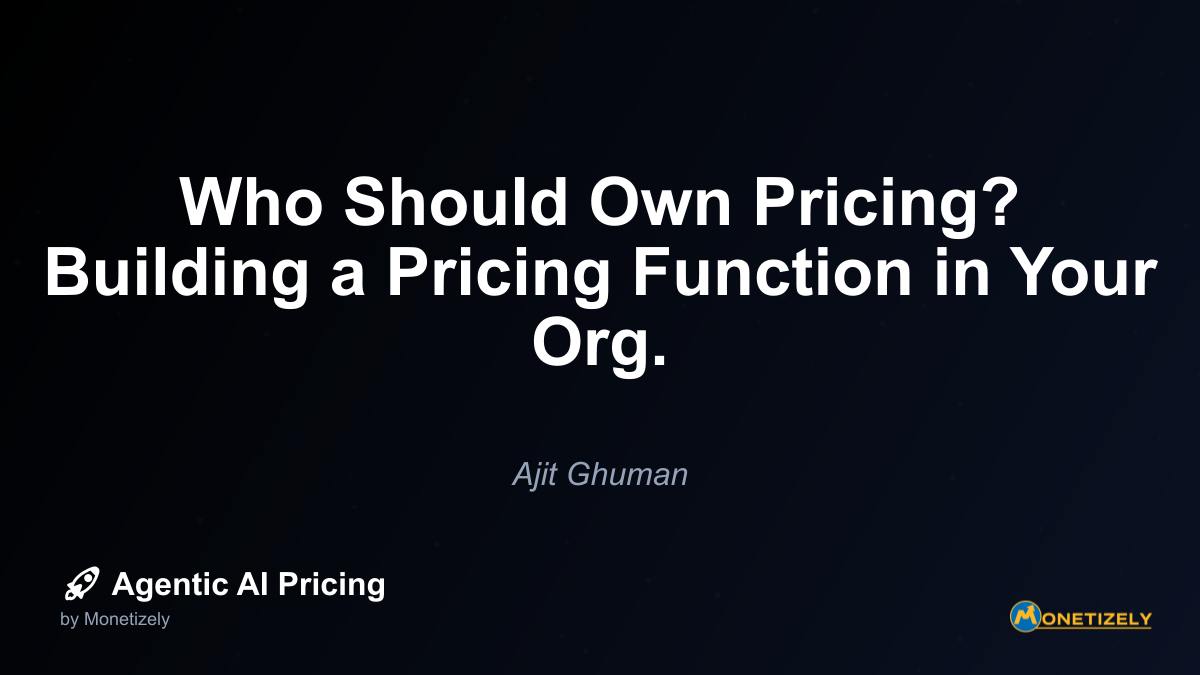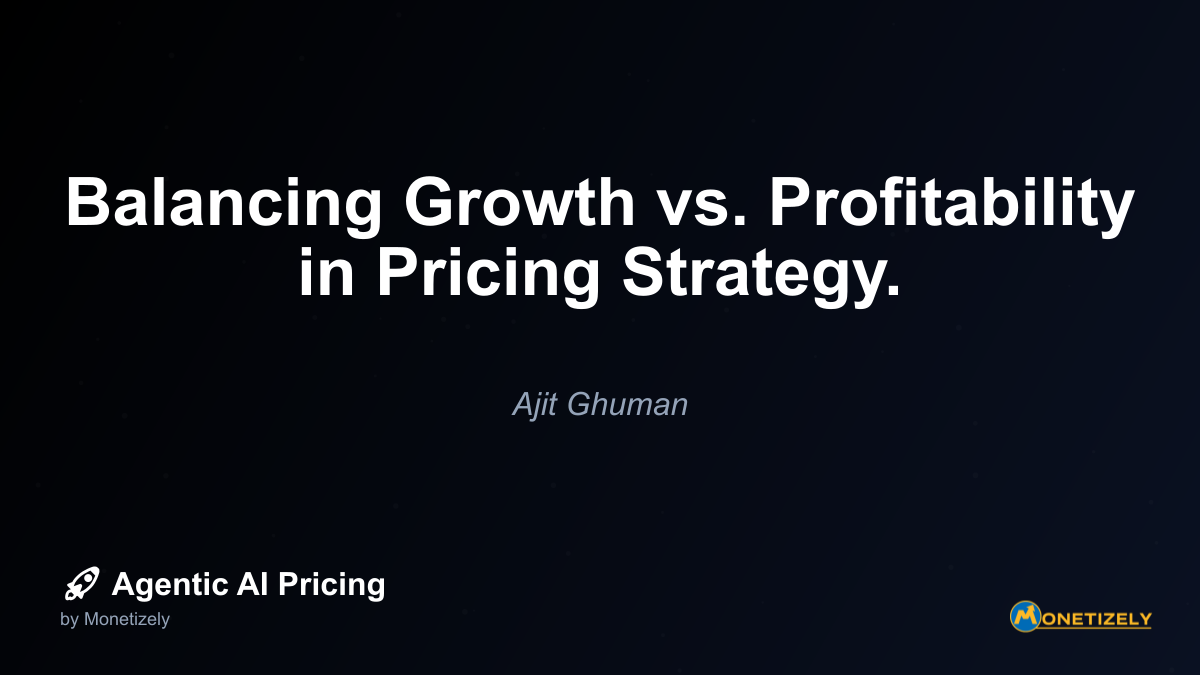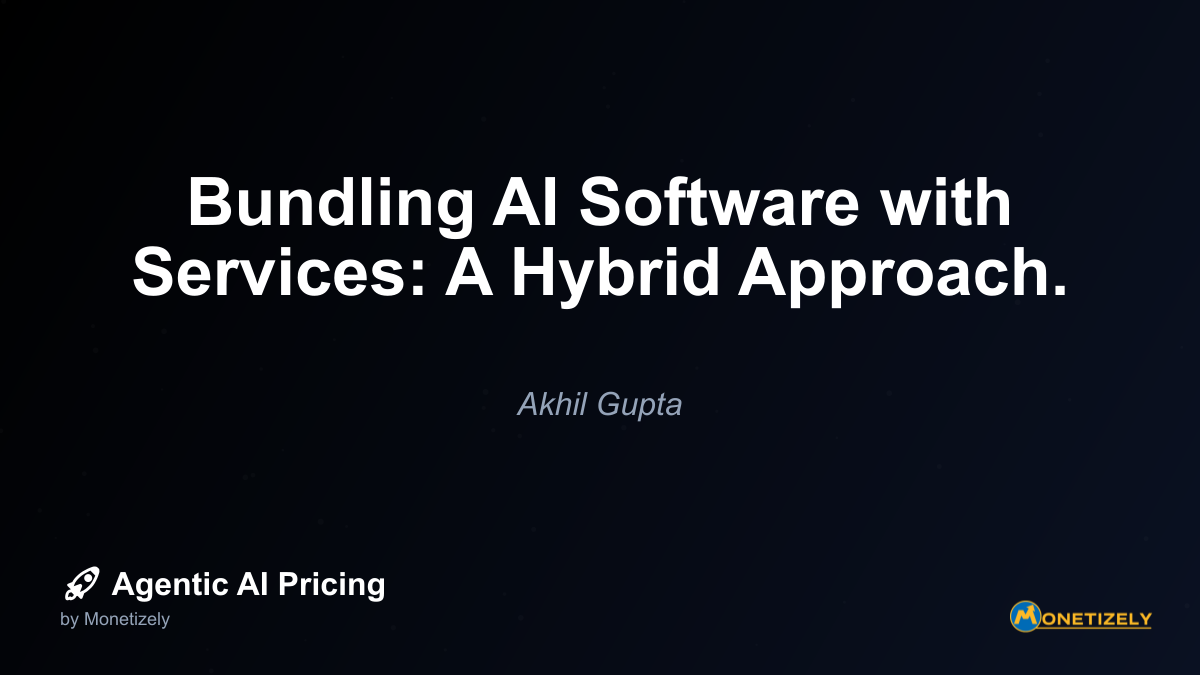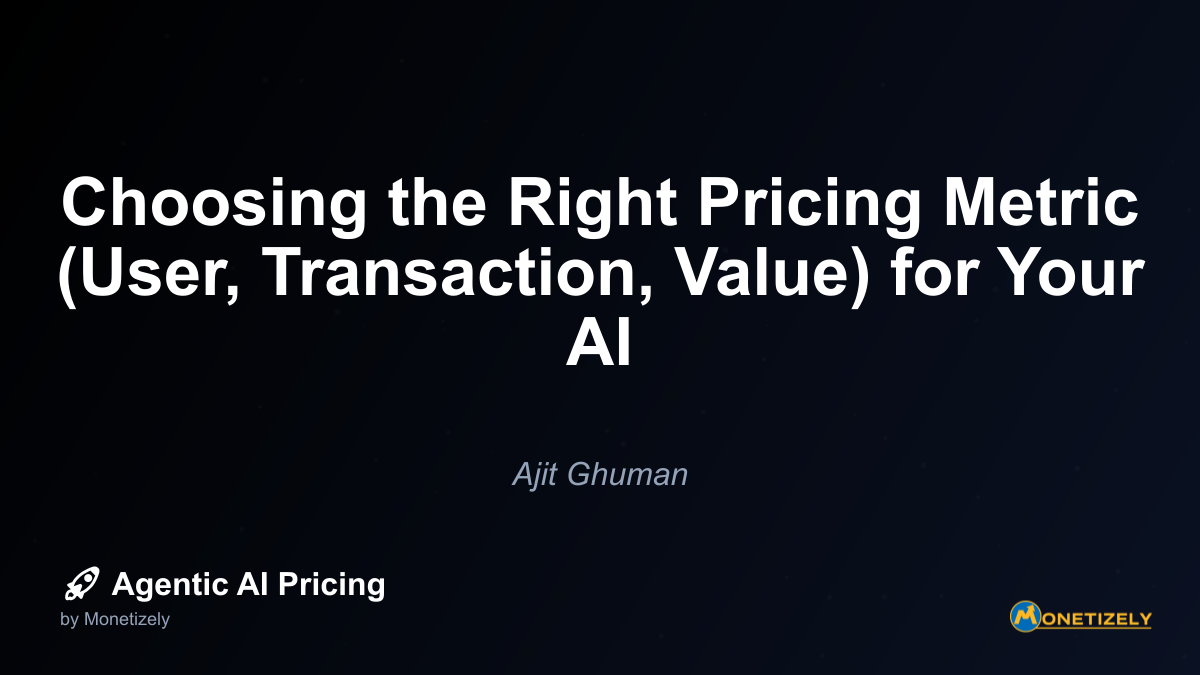· Ajit Ghuman · Strategy & Planning · 8 min read
Who Should Own Pricing? Building a Pricing Function in Your Org.
AI and SaaS Pricing Masterclass
Learn the art of strategic pricing directly from industry experts. Our comprehensive course provides frameworks and methodologies for optimizing your pricing strategy in the evolving AI landscape. Earn a professional certification that can be imported directly to your LinkedIn profile.

Building a Dedicated Pricing Function
For organizations implementing complex pricing models—especially those leveraging agentic AI with usage-based components—a dedicated pricing function often delivers significant ROI. If you’re considering establishing such a team, here’s a framework for success:
Organizational Positioning
Where the pricing function sits organizationally significantly impacts its effectiveness:
Reporting to Product
- Advantages: Close alignment with product strategy and value metrics
- Challenges: May lack financial rigor or commercial influence
Reporting to Finance
- Advantages: Strong financial discipline and metric focus
- Challenges: May lack customer empathy or product understanding
Reporting to Revenue Operations
- Advantages: Balanced perspective across commercial functions
- Challenges: May lack strategic influence at executive level
Reporting to Chief Revenue Officer
- Advantages: Strong commercial orientation and revenue focus
- Challenges: May over-index on short-term sales considerations
Reporting to CEO/COO
- Advantages: Strategic positioning and cross-functional authority
- Challenges: May lack specialized leadership or attention
The ideal positioning depends on your organization’s specific priorities, but increasingly, pricing functions are positioned within Revenue Operations or as a standalone function with direct executive visibility.
Core Responsibilities
Effective pricing functions typically own several key responsibilities:
Pricing Strategy Development
- Defining pricing models and structures
- Aligning pricing with company strategy
- Developing segmentation approaches
Price Setting and Optimization
- Setting specific price points
- Managing price tiers and thresholds
- Implementing value-based pricing methodologies
Pricing Analytics
- Analyzing price elasticity
- Measuring price realization
- Quantifying value metrics
Packaging and Monetization
- Designing feature packaging
- Developing upsell/cross-sell strategies
- Creating monetization frameworks
Pricing Operations
- Managing pricing tools and systems
- Implementing pricing changes
- Ensuring pricing compliance
Pricing Communication
- Creating value messaging
- Training sales on pricing approaches
- Developing pricing collateral
Competitive Intelligence
- Tracking competitor pricing
- Analyzing market positioning
- Developing competitive response strategies
Team Structure and Roles
As the pricing function matures, specialized roles typically emerge:
Pricing Leader/Director
- Sets pricing strategy and vision
- Secures executive buy-in for pricing initiatives
- Manages the pricing team and resources
Pricing Strategy Manager
- Develops pricing models and frameworks
- Leads pricing research initiatives
- Designs pricing experiments
Pricing Analyst
- Collects and analyzes pricing data
- Models pricing scenarios
- Measures pricing performance
Pricing Operations Specialist
- Implements pricing changes in systems
- Manages pricing tools and technology
- Ensures pricing accuracy and compliance
Value Messaging Manager
- Develops value propositions
- Creates pricing communication materials
- Trains customer-facing teams on value articulation
For AI-driven businesses with complex usage models, additional specialized roles may include:
AI Pricing Economist
- Models dynamic pricing algorithms
- Analyzes usage patterns and optimization opportunities
- Develops value-based pricing for AI capabilities
Usage Analytics Specialist
- Designs usage measurement frameworks
- Analyzes consumption patterns
- Identifies optimal metering points
Cross-Functional Interfaces
Even with a dedicated function, pricing remains inherently cross-functional. Successful pricing teams establish clear interfaces with:
Product Management
- Aligning on value metrics and packaging
- Coordinating feature releases with pricing changes
- Developing joint roadmaps for monetization
Finance
- Ensuring pricing supports financial targets
- Modeling revenue and margin impacts
- Developing pricing forecasts
Sales
- Creating deal desk processes for exceptions
- Training on value selling approaches
- Gathering competitive intelligence
Marketing
- Developing value messaging
- Coordinating pricing communication
- Aligning on segment targeting
Legal/Compliance
- Ensuring pricing practices meet regulatory requirements
- Developing compliant contracting language
- Managing pricing transition terms
Customer Success
- Understanding renewal impacts
- Gathering feedback on pricing friction
- Identifying expansion opportunities
Pricing Governance for AI and Usage-Based Models
For companies implementing agentic AI with usage-based pricing components, governance becomes particularly critical. These models introduce unique challenges:
- Metric Selection Complexity: Choosing which usage dimensions to meter
- Value Alignment: Ensuring usage metrics correlate with customer value
- Predictability Concerns: Helping customers forecast their costs
- Experimentation Needs: Continuously refining pricing parameters
- Technical Implementation: Integrating metering with billing systems
To address these challenges, consider this governance framework specifically for AI and usage-based pricing:
1. Establish a Usage Pricing Council
Create a dedicated cross-functional team that meets regularly to:
- Review usage patterns and identify pricing opportunities
- Approve changes to usage metrics or thresholds
- Evaluate customer feedback on usage pricing
- Coordinate technical implementation of metering changes
2. Implement a Pricing Experimentation Framework
Develop a structured approach to testing pricing hypotheses:
- Define clear experiment goals and success metrics
- Create controlled test environments
- Establish statistical significance thresholds
- Document learnings and build institutional knowledge
Expert-level testing methodologies are particularly important for optimizing complex AI pricing models, where small parameter adjustments can have significant revenue impacts.
3. Create Usage Pricing Dashboards
Develop real-time visibility into usage patterns:
- Track usage distribution across customer segments
- Monitor utilization against purchased entitlements
- Identify customers approaching usage thresholds
- Analyze correlation between usage and retention
4. Establish Value Metric Reviews
Regularly evaluate whether your chosen usage metrics align with customer value:
- Analyze correlation between usage and customer outcomes
- Gather feedback on perceived fairness of usage pricing
- Compare usage patterns across customer segments
- Identify opportunities for new value metrics
5. Develop Clear Decision Rights
Document who has authority for different types of pricing decisions:
- Strategic model changes (e.g., switching from subscription to usage)
- Tactical parameter adjustments (e.g., changing usage thresholds)
- Exception processes (e.g., approving custom pricing)
- Emergency responses (e.g., addressing competitive threats)
Case Studies: Pricing Ownership Evolution
Early-Stage AI Company: Product-Led to Dedicated Function
An early-stage AI document processing company initially placed pricing ownership with their product team. This worked well during initial product development, as the product team had the deepest understanding of how customers derived value.
As they scaled, however, they faced challenges:
- Sales teams requested excessive discounting authority
- Finance pushed for higher margins without understanding value metrics
- Product teams lacked bandwidth for pricing optimization
Their solution was to hire a dedicated pricing manager reporting to the Chief Revenue Officer, who:
- Built a pricing experimentation framework
- Developed usage analytics dashboards
- Created a cross-functional pricing committee
- Implemented a structured exception process
The result was a 22% increase in average contract value and improved pricing consistency across customer segments.
Enterprise SaaS Company: Committee to Center of Excellence
A mature SaaS company with an established pricing committee faced challenges implementing AI features with usage-based components. Their committee approach, which worked well for subscription pricing, proved too slow for the dynamic nature of usage-based models.
They evolved their approach by:
- Creating a dedicated Pricing Center of Excellence
- Hiring specialized AI pricing analysts
- Implementing dedicated pricing technology
- Developing a rapid experimentation framework
This transformation allowed them to launch complex AI features with optimized pricing, resulting in 15% higher adoption rates and 30% higher revenue per customer for AI capabilities.
AI Platform Provider: Finance-Led to Product-Finance Partnership
A leading AI platform provider initially positioned pricing under Finance, focusing primarily on margin requirements and competitive positioning. As their platform evolved to include dozens of AI services with different usage patterns, this approach became unsustainable.
They restructured by:
- Creating a joint Product-Finance pricing team
- Developing specialized expertise in AI usage patterns
- Implementing sophisticated usage analytics
- Building a value-based pricing framework for AI capabilities
This partnership approach allowed them to optimize across both customer value and financial requirements, resulting in more sustainable growth and improved customer satisfaction.
How to Determine the Right Pricing Ownership for Your Organization
To assess the optimal pricing ownership model for your specific situation, consider the following framework:
1. Evaluate Your Pricing Complexity
Rate your pricing complexity on these dimensions (1-5 scale):
- Number of products/services
- Pricing model sophistication
- Market segmentation complexity
- Competitive dynamics
- Technical implementation requirements
Higher total scores (15+) typically indicate the need for dedicated pricing resources.
2. Assess Your Pricing Maturity
Consider your current pricing capabilities:
- Do you have documented pricing processes?
- Do you regularly analyze pricing performance?
- Do you conduct systematic pricing research?
- Do you have specialized pricing tools?
- Do you test pricing hypotheses?
Less mature organizations may benefit from establishing cross-functional governance before investing in dedicated resources.
3. Consider Your Growth Stage
Different stages typically align with different ownership models:
- Startup: Founder/executive-led pricing
- Growth stage: Functional ownership (Product/Marketing/Sales)
- Scale-up: Cross-functional committee
- Enterprise: Dedicated pricing function
4. Evaluate Your Strategic Priorities
Your specific business priorities should influence ownership:
- Rapid innovation → Product-led pricing
- Margin improvement → Finance-led pricing
- Market share growth → Sales-led pricing
- Complex optimization → Dedicated function
5. Assess Your Organizational Culture
Cultural factors significantly impact pricing governance success:
- Decision-making style (consensus vs. hierarchical)
- Data orientation (intuitive vs. analytical)
- Cross-functional collaboration norms
- Change management capabilities
The optimal model must align with your organization’s cultural realities.
Implementation Roadmap
If you’re ready to evolve your pricing ownership model, consider this phased approach:
Phase 1: Establish Governance Foundation (1-3 months)
- Document current pricing processes
- Create a simple RACI matrix for pricing decisions
- Implement regular pricing review meetings
- Develop basic pricing performance metrics
Phase 2: Build Cross-Functional Alignment (3-6 months)
- Create a formal pricing committee charter
- Develop shared pricing principles
- Implement a structured exception process
- Build basic pricing tools and templates
Phase 3: Develop Specialized Capabilities (6-12 months)
- Hire or develop dedicated pricing expertise
- Implement pricing analytics capabilities
- Create a pricing experimentation framework
- Develop value-based pricing methodologies
Phase 4: Optimize and Scale (12+ months)
- Establish a formal pricing function
- Implement advanced pricing technology
- Develop specialized roles and career paths
- Create centers of excellence for complex areas
Conclusion: Making the Right Choice for Your Organization
The question of who should own pricing doesn’t have a universal answer—it depends on your specific context, complexity, and strategic priorities. However, several principles apply across organizations:
Explicit is better than implicit: Whatever model you choose, make ownership explicit rather than assumed.
Evolution is inevitable: Your pricing ownership model should evolve as your business grows and your pricing sophistication increases.
Cross-functional input remains critical: Even with dedicated ownership, pricing decisions benefit from diverse perspectives.
Capability building matters most: Focus on developing pricing capabilities, regardless of where they sit organizationally.
Data drives success: Invest in the analytics and insights that enable informed pricing decisions.
For organizations implementing agentic AI with complex usage-based components, the case for dedicated pricing resources becomes particularly compelling. The optimization opportunities in these models often justify specialized expertise and focused attention.
As you evaluate your own pricing ownership strategy, remember that the goal isn’t perfection but progress—moving from reactive, ad hoc pricing decisions to a structured approach that treats pricing as the strategic lever it truly is.
With clear ownership, appropriate governance, and the right capabilities, pricing can transform from an occasional consideration to a continuous source of competitive advantage—especially critical as AI transforms business models and creates new monetization opportunities.
Co-Founder & CEO
Ajit is the author of Price To Scale, a top book on SaaS Pricing and is the Founder of Monetizely. Ajit has led and worked in pricing and product marketing at firms like Twilio, Narvar and Medallia. His work has been featured in Forbes and VentureBeat. Ajit regularly consults with software companies from Seed stage to post-IPO on pricing strategy. Ajit is also a highly-rated co-instructor for 'The Art of SaaS Pricing and Monetization' on Maven.
Pricing Strategy Audit
Let our experts analyze your current pricing strategy and identify opportunities for improvement. Our data-driven assessment will help you unlock untapped revenue potential and optimize your AI pricing approach.




